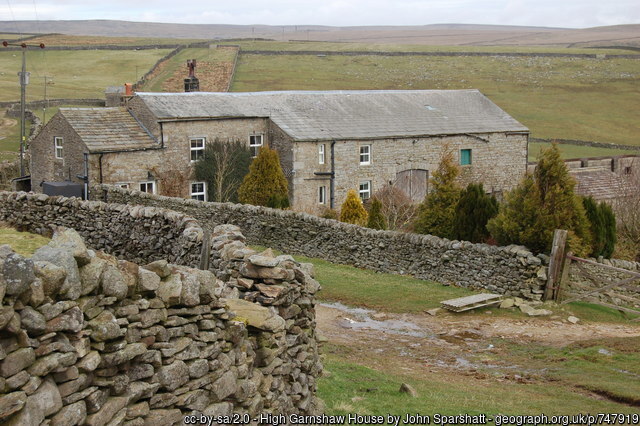
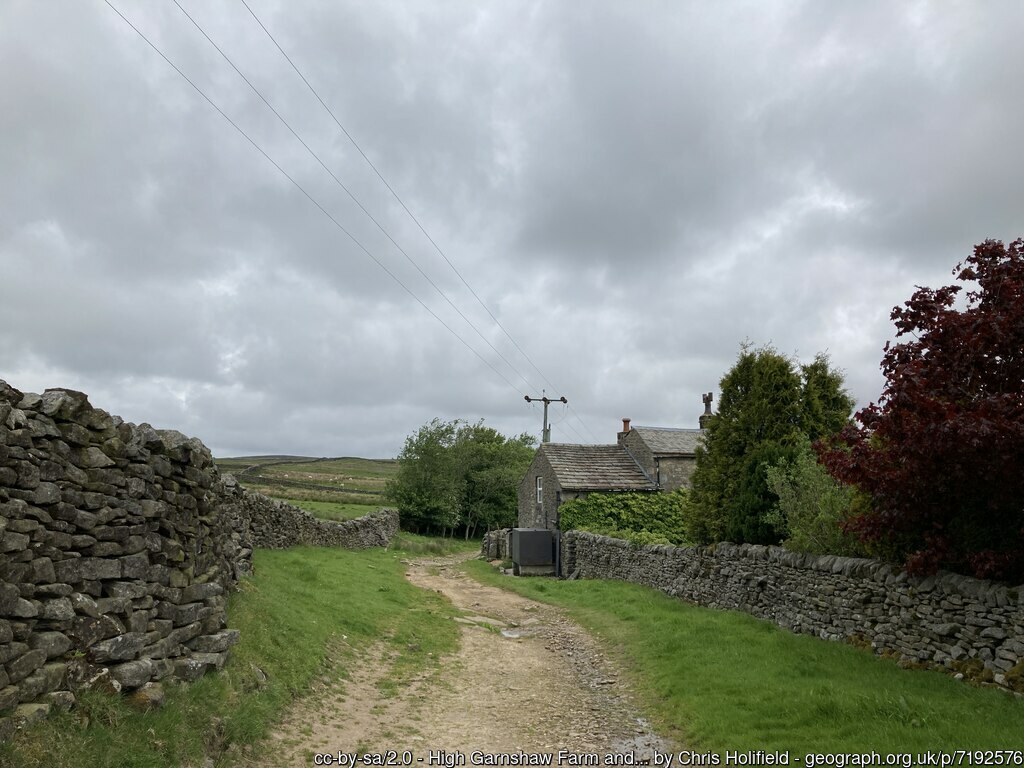
The trees tell you all you need to know about the weather, strategically placed to counter the wind, rain and snow blowing off Mire Ridge to the west. The substantial stone walls bordering Tinkers (historically Tinklers) Lane carry their own story, of an ancient thoroughfare now forbidding to all but the most substantial vehicle. This is High Garnshaw, Hebden, home to several generations of our ancestors and Wellock cousins spanning 250 years.
The Wellocks have been linked to Linton in Craven ever since William Walok paid 4d of poll tax in 1379. (Incidentally this reference led me to researching the Peasants Revolt of 1381 and from there to a reference to Linton & Rylestone participants in the 1569 Northern Rebellion….but that will need to be a subject of another blog). Hebden was historically part of Linton-in-Craven parish but sufficiently different to be noted in the records.
Records from here on variously refer to Garnshaw, High Garnshaw, Tinkler’s Lane or even just Hebden. Whilst it’s hard to be certain these all refer to the same place (particularly as there is both a High Garnshaw and a Garnshaw house in close proximity), I take heart from Harry Speight, who in 1900 wrote the following about Linton “There are still resident in the parish several worthy families, descendants of the old yeoman class, who have lived on the land held by their forefathers for generations and even centuries.” Whilst the ever-present Harry neglects to make any mention of the Wallocke or Wellock families in his book “Upper Wharfedale” he was not alone in this characterisation of the people who lived in the parish of Linton for Rev. Thomas Dunham Whitaker wrote thus “the tenantry lived in so much plenty and security, the tenements descended so regularly from father to son” in his book “The History and Antiquities of the Deanery of Craven, in the County of York” published in 1818.
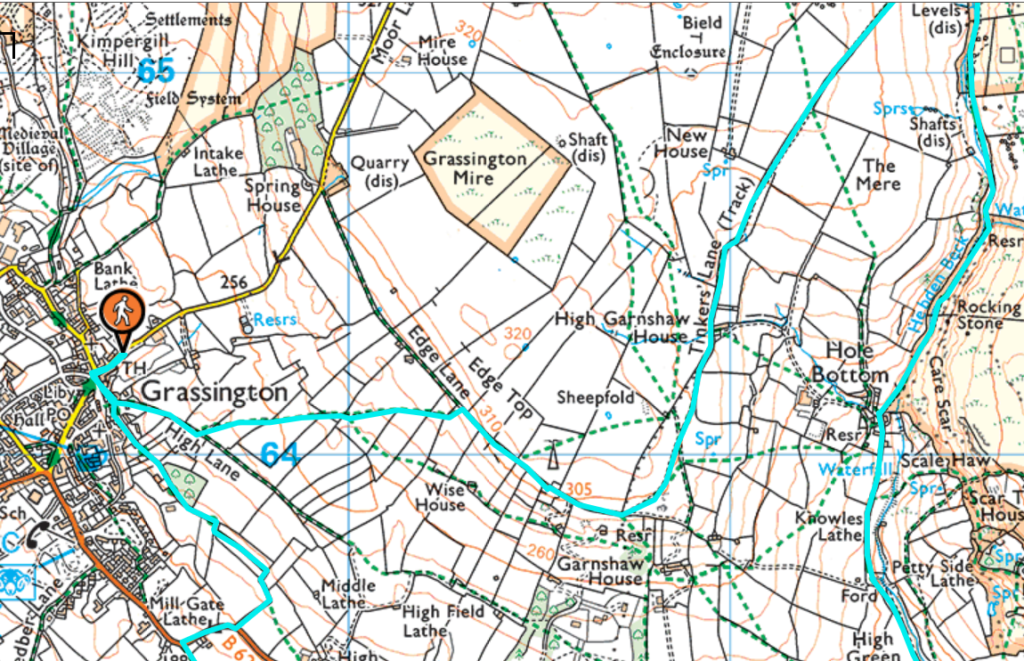
Here follows a timeline showing the evidence of our connection to Garnshaw.
1651 – “John & Mary Twins of James Symson of Garneshaw bapt. 11o of May.”
The very first mention of Garnshaw belongs to our 9xG Grandfather, James Symson. James married Isabell Ramell in 1639 and by the time the twins were born had already baptized three children. It is entirely possibly James himself was born and brought up on the same farm. Sadly this baptism was not a happy occaision. Isabell likely died in childbirth (being buried on 4 May 1651 and the twins were to follow on 7 December the same year). Agnes, (b. 31 December 1653) James’s daughter with his second wife, Mary, was to marry George Wellock in 1674 and thus begin the connection between the Wellocks & Garnshaw.
1674 – “Robert son of George Wallocke [was] borne at Garneshaw bapt. 16to Augusti [1674]” followed swiftly on from “George Wallocke & Agnes Symson both of this Parish were married 28th day of April [1674]” suggesting that the newly married George had moved in with his father-in-law James.
1685 – “Willm son of George Wallocke Garneshaw bapt. 18th day of October.” George & Agnes were to have three further children including our 7x G Grandfather, William.
1702 – “Robert Wellock of Garnshaw burd ye 18 day of June.” Robert’s untimely death in 1702 (he would have been just 28) brought to an end this first period of connection to Garnshaw. William (our direct ancestor) (1685 – 1758) would have been too young to take over the property and clearly struggled to find a permanent tenancy, moving from Grassington to Threshfield to Coniston Cold all within a few miles of Garnshaw. William’s son William (6x G Grandfather) (1726 – 1813) was to establish a base at Upper Cow House in Winterburn where his son William (5x G Grandfather) (1748 – 1813) was born.
There is then a 50 year and three generation gap before we return to High Garnshaw.
1795 – “Richd. son of Richd. Wellock Tinkler lane Bapd. [June] 28th” – it was William’s son Richard (4 x G Grandfather) (1765 – 1849) who was to re-establish the Wellock connection to High Garnshaw. Richard married Mary Windsor at Arncliffe in 1789. Their first child, Jenny, was also baptized at the church there. By the time their son William arrived in 1792 the couple were described as living “near Hebden” and then in 1795 as “Tinkler Lane.” Whilst there would have been other dwellings on Tinkler Lane, the evidence of subsequent family connection to this specific property causes me to believe that they were now living at High Garnshaw house itself.
1810 – “Thomas son of Richard Wellack Tinkler lane, Farmer, Bapd. [June] 24th” – our 3 x G Grandfather, Thomas, was the eighth of Richard & Mary’s eleven children. Thomas was to establish another multi-generational tenancy at Toft Gate at Greenhow Hill. However, it was Thomas’s youngest sibling, Robert, who was to continue the connection the Wellock to High Garnshaw.
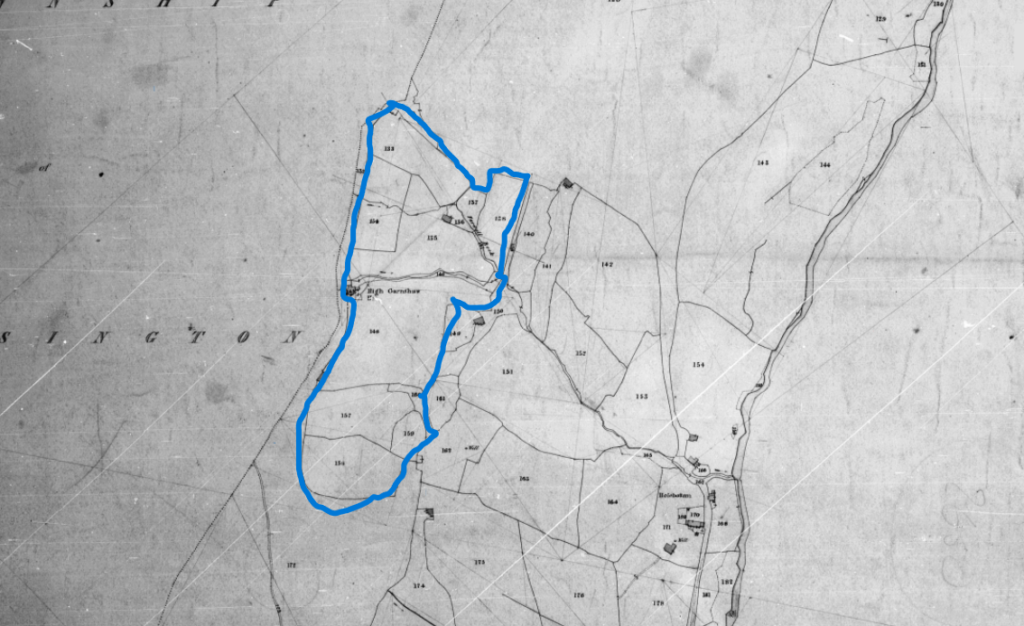
1846 – thanks to a translation of the 1842 tithe assessment we can see the exact fields which made up the farm of High Garnshaw: Old House Field, Little Field, Low Laithe Field, Garth, Cow Garth, Far Field x 2, Strip, Intake, Paddock & Wogan Meadows plus the house itself were all occupied by Richard Wellock. The distinctive curve of Intake field (bottom left) can still be seen on modern photos.
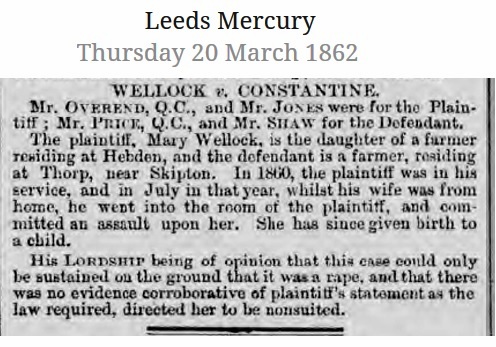
1860 – Mary, Robert’s eldest daughter, went to work for a nearby farmer. In 1860, Mary alleged that a Mr Constantine “went into the room of the plaintiff, and committed an assault on her.” Mary moved back in with her family to have the baby and is recorded as living at High Garnshaw, together with her 4 day old daughter Fanny, in the 1861 census. Whilst at the time the case was judged to be nonsuited (meaning dismissed for lack of evidence) it is very hard to imagine a farmer’s daughter in the 1860s choosing to go to court to pursue a false allegation.
1865 – Robert’s youngest son, Jenkinson Wellock, was born. Jenkinson married Ellen Moore in 1888 and they had five children together.
1897 – John William Wellock, Jenkinson’s middle child, was born in 1897. John served in the West Riding regiment in WW1 and was killed in action on 8 September 1918. Although the family had moved out by the time of the war, John is remembered on the Hebdenhistory website.

1903 – John’s sister, Ellen, was the last Wellock child to be born at High Garnshaw on 21 February 1903.
By the time of the 1911 census, the Wellocks had moved out of High Garnshaw. Jenkinson, was boarding separately from his family with a woman he later went on to marry.
Ellen was my great grandmother (Mary Wellock)’s cousin and the 6x great grandchild of James Symson with whom we started our story.
In tracing our Wellock ancestry I owe a deep gratitude to my sister’s friend, Hazel Ratcliffe, whose daughter happened to have a child with a Wellock third cousin of ours and who kindly shared her research into our shared Wellock ancestry. I also am grateful to the Rev. F.A.C. Share M.A., Rector of Linton, who patiently transcribed the parish registers for St Michaels and All Angels Church, Linton in Craven for the Yorkshire Parish Register Society. These were published in 1900 (available on www.archive.org) and are the source for everything I quote in italics above. My final thanks go to the author of www.hebdenhistory.org for making the census and other research so much swifter.

Hi Natasha ,
Thank you for all your research on the Wellocks of Garnshaw. I have traced my family back to Garnshaw but trying to connect them to the Wellock family in Malham . In your paragraph starting ….” 1702, Robert Wellock of Garnshaw…….” Howard’s the end of that paragraph you say, “ George’s son William, 1726-1813……” this is the connection to the other family, but can you tell me which George is Williams father please? It can’t be George of 1647-1694 or George of 1730- is there another one I’ve missed—-I get very confused with the repeated names . If you could help it would be great , thank you,
Richard Wellock
Do we know what Mr. Constantine’s given name is? I have ancestors that lived in Hebden … Richard Constantine being one.
I did have a go at trying to find out who he was. Let me dig back into my records.
Hi, so just gone back through research. I think the Mr Constantine in question was John Constantine (b. c. 1825 in Appletreewick) son of Richard Constantine (b. c. 1795).
He is, as far as I can tell, the only Constantine in Thorpe, Yorkshire, in the 1861 census which would have been just under a year after the incident. He was married (the article mentions a wife), and his children were listed in the 1861 census as being born in Thorpe (so he was there the year before) and he is a farmer and has a female domestic servant in the household (replacement for Mary no doubt).
The Constantine family does have a close connection with Hebden (as you yourself know) where Mary was from, and indeed Thorpe isn’t that far away, but I haven’t yet found a family connection as the majority of farm servants, domestic or otherwise, tended to be relatives – perhaps though, in this case, that would have been counter evidence. Anyway, if you can’t link him into your family let me know and I’ll give it a go. I’ve been meaning to research and write this up more fully so now I can!
Hi Natasha,
Very useful information with regards to Wellocks of Garnshaw, I noted I have a DNA match with a member of your family so a lot of the information is so relevant to my own ancestry research. Only when I started researching my family in recent months did I find so much information about the Wellocks which I had no idea about and to find out I am from the ‘other side’ of the Pennines was enlightening 🙂
I also read Richard Wellock’s note above which is really interesting. So it will interesting to see how that ties in.
Incidentally both my Son and Daughter are not far from you in London,
Kind regards,
Colin Wellock